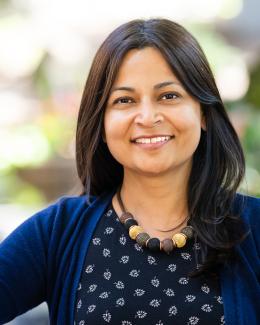December 2, 2016 – Udaya Kalluri brings considerable energy to her plant research at the Department of Energy's Oak Ridge National Laboratory—a trait colleagues describe as “contagious enthusiasm.”
Kalluri’s zeal was evident even in her postdoc days at ORNL, when she won lab-directed research funding combining nanotechnology and proteomics, to research cellulose formation in plants. With 10 years of experience as a staff scientist in ORNL’s Biosciences Division (BSD), Kalluri focuses her work around lab programs such as DOE’s BioEnergy Science Center (BESC) to create better biofuels, improve plant productivity, and study beneficial plant-microbe interactions.
“I call myself a plant biologist, and the most interesting part of my work here at ORNL is bringing to bear tools from conventionally distant disciplines to understand plants and plant functions—say, neutron sciences, and physical sciences,” Kalluri said. “In system biology and -omics studies of plants, we generate a ton of data that feeds back into our understanding of plants. If you were analyzing datasets for just one organism, then a server might be fine. But if you’re analyzing a whole population of individuals, you really need a supercomputer.”
In her genomics research, Kalluri collaborates with protein modelers and genome analyses experts to gain novel insights using the Titan supercomputer at the Oak Ridge Leadership Computing Facility and the Spallation Neutron Source, both DOE of Science User Facilities at ORNL. Such insights have led to a high-impact article on the structure of a key cell wall enzyme complex and a patent filing on a method to improve biomass density and sugar release efficiency, this year alone.
Kalluri’s training in molecular biology as an undergrad in India got her fascinated with DNA, RNA, and proteins, and how they shape complex biosystem properties. An internship at a United Nations-funded research Institute first exposed her to the power of basic research in unlocking solutions to challenging global needs. Kalluri later pursued her PhD at Michigan Technological University (MTU), where her studies concentrated on cellulose biosynthesis as a biochemical pathway in Populus, which was being sequenced as the first tree species—a connect that brought her to ORNL as a postdoc.
The interdisciplinary ORNL environment encourages innovative research, Kalluri said. “It can be so quick, from thinking about something, to talking with someone, to conducting breakthrough research—and now I’ve had several projects with people I perhaps wouldn’t have interfaced with in an academic setting, demonstrating concepts that have resulted in new conference sessions. That atmosphere has been energizing and motivating for me since my earliest days here.”
Perseverance pays off
Kalluri recognizes the challenge of balancing a career in the fast-moving world of science with family and parenting needs. “In the sciences especially, if you take your foot off the pedal, it’s hard to come back with the same steam because the rest of the research world is moving quickly,” she said.
She took five years on and off to spend time with her two children, aged 2 and 5, but she carefully prepared for that time away from the lab. “I strategically planned to have papers coming out during that time. I laid the seeds for more work before I took time off to hit the ground running once I returned to full time work. It helped to be intentional about maintaining my project productivity and presence in the community during that time,” she said.
Kalluri brought the same passion to mentoring and outreach during her time as the science coordinator of the DOE BioEnergy Science Center, her involvement in the creation of a traveling science exhibit, and as an alumnus serving on the board of MTU’s School of Forest Resources and Environmental Science.
“If we’re going to tackle the big science problems, which need research on decadal time scales, we need to engage more creative minds early,” Kalluri said. “Such engagement could be something as simple as giving a greenhouse tour here at the lab. I’ve seen high school students light up and get excited about science, realize the career options and that it’s possible for them. We need to engage those who could turn out to be future science leaders. We need more buy-in.”
ORNL and the many mentors Kalluri says she has been fortunate to associate with have “supported me in my journey as a plant biologist —in going beyond the convention, to creatively and effectively navigate cross-disciplinary boundaries. And not just that, but to make discoveries about the biological process I’m studying, which could be cell wall biosynthesis, or it could be how microbes and plants signal and sense each other and come together during symbiosis. These exciting fundamental research questions are key to enabling sustainable biofuel and biomaterials applications,” she said. “That’s the gist of what I do.”
“You can do truly innovative research at ORNL,” Kalluri stressed. “If you can imagine it, you can do it. You just have to have the perseverance to make it happen.”
UT-Battelle manages ORNL for the Department of Energy's Office of Science. The Office of Science is the single largest supporter of basic research in the physical sciences in the United States, and is working to address some of the most pressing challenges of our time. For more information, please visit http://energy.gov/science/. —by Stephanie Seay


